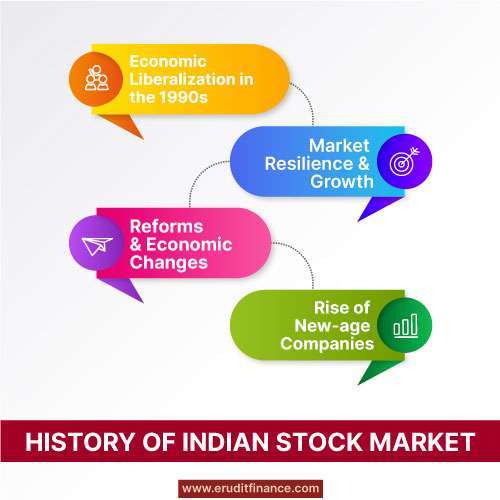The history of the Indian Stock Market dates back to the 19th century when the Bombay Stock Exchange (BSE) was established in 1875, making it one of the oldest in Asia. Over the years, the market has witnessed significant milestones, including the formation of the National Stock Exchange (NSE) in 1992, introducing electronic trading. Economic reforms in the early 1990s further propelled market growth, attracting domestic and foreign investors. The market has since evolved with technological advancements, regulatory changes, and increased participation, solidifying its position as a vital component of India’s financial landscape.
History of Indian Stock Market

Establishment of Bombay Stock Exchange (BSE)-The roots of the Indian Stock Market trace back to 1875 with the founding of the Bombay Stock Exchange (BSE), making it one of the oldest in Asia. It initially facilitated trading in stocks and shares of cotton mills, providing an organized platform for capital raising.
Challenges in the Early 20th Century– The stock market faced challenges during the early 20th century, including the economic impact of World War I and the Great Depression. However, it rebounded in the post-independence era as India initiated economic reforms.
Government Intervention and Nationalization- In the 1960s and 1970s, the Indian government nationalized major banks and financial institutions, aiming to regulate the financial sector. This period saw increased government intervention in economic affairs.
Economic Liberalization in the 1990s- The 1990s marked a turning point with economic liberalization policies. Finance Minister Manmohan Singh led these reforms, dismantling the License Raj and opening doors to foreign investment.
Establishment of National Stock Exchange (NSE)- In 1992, the National Stock Exchange (NSE) was established, introducing modern technologies like electronic trading and dematerialization of securities. This enhanced market efficiency and transparency.
Market Resilience and Growth- Despite global financial crises, such as the 2008 recession, the Indian Stock Market showcased resilience and continued to grow. The Sensex crossed the 10,000 mark in 2006, reflecting the market’s potential.
Regulatory Role of SEBI- Regulatory bodies like the Securities and Exchange Board of India (SEBI) played a crucial role in maintaining market integrity and protecting investors. SEBI implemented reforms to enhance transparency and accountability.
Reforms and Economic Changes- Reforms such as the introduction of the Goods and Services Tax (GST) and Insolvency and Bankruptcy Code (IBC) strengthened the market ecosystem. These changes aimed at streamlining taxation and resolving insolvency issues.
Rise of New-age Companies- In recent years, the market has witnessed the rise of new-age companies in sectors like technology and e-commerce. This contributed to India’s emergence as a global economic player.
Fintech Integration- The integration of financial technologies (fintech) transformed trading and investment processes, making them more accessible and efficient.
Who Is the Founder of Indian Stock Market?
The Indian Stock Market was formally established with the founding of the Bombay Stock Exchange (BSE) in 1875. However, it’s important to note that the creation and development of the stock market in India involved the collective efforts of several individuals and institutions over time. Premchand Roychand, a prominent businessman of that era, founded the BSE. Premchand Roychand played a key role in shaping the early structure of the BSE and contributed significantly to the growth of the Indian Stock Market. While he is often regarded as a major figure in the establishment of the BSE, it’s essential to recognize that the market’s evolution was a collaborative process involving various contributors.
Which Is India Oldest Stock Market?
The Bombay Stock Exchange (BSE) is the oldest stock market in India. Established in 1875, it has a rich history and is one of the oldest stock exchanges in Asia. The BSE played a pivotal role in laying the foundation for organized stock trading in the country and has been a key player in developing the Indian financial market over the years.
Who Controls Stock Market in India?
The Securities and Exchange Board of India (SEBI) is the regulatory authority that controls and regulates the stock market in India. SEBI was established in 1988 as an autonomous body to protect the interests of investors and promote the development and regulation of the securities market. It formulates and enforces rules and regulations for various market participants, including stock exchanges, brokers, and listed companies. SEBI plays a crucial role in ensuring transparency, fairness, and integrity in the Indian stock market, and it has the authority to investigate and take enforcement actions against any violations of its regulations.
When Did BSE Start in India?
The Bombay Stock Exchange (BSE) started in India on July 9, 1875. Established by Premchand Roychand and others, the BSE is one of the oldest stock exchanges in Asia and has played a significant role in the development of India’s financial markets over the years.
How Many Stock Markets Are There in India?
Bombay Stock Exchange (BSE)- Established in 1875, and located in Mumbai, it is one of the oldest stock exchanges in Asia.
National Stock Exchange (NSE)- Founded in 1992, and also located in Mumbai, it has grown to become one of the largest and technologically advanced stock exchanges in India.
Additionally, there are regional stock exchanges that play a role in specific areas, but their significance has diminished over the years. Some of these include:
Calcutta Stock Exchange (CSE)- One of the regional stock exchanges, it was established in 1908. However, its operations have significantly reduced over time.
Madras Stock Exchange (MSE)- Founded in 1920, it is another regional stock exchange. Like CSE, its significance has diminished, and it operates on a smaller scale compared to BSE and NSE.
Ahmedabad Stock Exchange (ASE)- Established in 1894, it is one of the oldest exchanges in India. However, its operations have also seen a decline.
It’s important to note that the relevance of regional stock exchanges has waned with time, and the BSE and NSE are the primary platforms for stock trading in India.
What Was the First Stock Market in the World?
The Amsterdam Stock Exchange, established in 1602 by the Dutch East India Company, is considered the world’s first official stock exchange. It allowed investors to buy and sell company shares, making it a pioneer in publicly traded companies and organized securities trading. This marked the beginning of modern stock exchanges where securities could be bought and sold in a regulated environment, setting a precedent for the development of financial markets around the world.
What Is the Full Form of Nifty?
The term “Nifty” is derived from the combination of two words “National” and “Fifty.” Therefore, the full form of Nifty is “National Fifty,” representing the National Stock Exchange’s benchmark stock market index in India, officially known as the Nifty 50. The Nifty 50 index comprises fifty actively traded stocks from various sectors listed on the National Stock Exchange of India (NSE). It serves as a key indicator of the Indian equity market’s performance and is widely used by investors and traders for tracking the overall market trends.
Bottomline:-
The Indian Stock Market, rooted in the establishment of the Bombay Stock Exchange in 1875, has undergone a transformative journey. Shaped by economic reforms in the 1990s, the introduction of the National Stock Exchange, and regulatory oversight by SEBI, the market has grown resilient. It weathered global financial crises, embraced technological advancements, and witnessed the rise of new-age companies. With a rich history marked by milestones, the stock market remains a vital component of India’s financial landscape, reflecting its dynamic economic growth and continual evolution.
Also Read:










